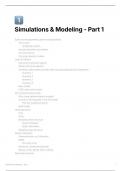Summary
Summary 20599 - Simulations and Modeling Notes Pt.1 (DSBA)
- Course
- Institution
These notes cover the main simulation and modeling models of population growth and interaction, with epidemiological applications. Euler's geometric growth model with introduction of births and deaths, and the Lotka-Volterra model for prey and predators are covered. Advanced models such as the SIR ...
[Show more]



